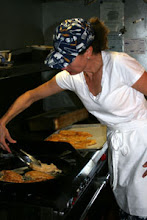 No, the title isn't an oxymoron, although I guess we don't normally think of onions as sexy.
No, the title isn't an oxymoron, although I guess we don't normally think of onions as sexy.Fresh peeled fava beans, yes. A bowl of diced, pungent white onions? No.
In fact, it might even seem a little offensive, but what would a bowl of chili be without a spoonful of diced onions?
There are associations for just about every food on the planet. There's the egg board, the pork council, the fig growers association and so on.
Imagine trying to market onions. Yet onions are the pillar, the unsung hero, if you will, of almost every cuisine.
Last week, I was strolling through the exhibit hall at a culinary conference, elbowing my way through the crowd to taste incredible American lamb, buttery cheeses from Wisconsin, and deep, dark, organic chocolate.
And then I turned the corner and saw the onion booth. Not very exciting, you say? On the surface, it may seem that way, but to me, there is nothing sexier than caramelized onions -- sweet, rich, utterly delicious.
Smartly, the National Onion Association decided to serve caramelized onions, a pile of jammy, chipotle infused onions served atop a plain, thin cracker, just something to hold the mound of lusciousness without getting in the way of the flavor.
Caramelizing onions is a simple process, but it takes time. If I know I'm going to be cooking for 45 minutes anyway, I'll caramelize a pan of onions at the same time, even if I don't plan to use them that evening. Caramelizing onions takes anywhere from 30 to 60 minutes, depending upon the technique.
If you can give your undivided attention, you can caramelize onions in about 30 minutes using high heat and a lot of elbow grease.
On the other hand, if you want to slowly coax the natural sugars out of the onions, plan on 60 minutes, but you don't have to give the process your full attention until the last 15 minutes.
You can caramelize any type of onion. Red, yellow, white, sweet, cipollini, pearl or even spring or green onions, although the green (scallions) onions are lower in natural sugar, and therefore aren't quite as partial to caramelizing. You can use olive oil or butter. A pinch of sugar is fine, too, although I've found most onions, especially sweet onions, don't really need added sugar.
The darker you caramelize your onions, the deeper the flavor, but you'll need to stir constantly near the end to prevent scorching. After I've caramelized onions to a deep, mahogany brown, I like to splash in a little acid (like orange juice or white wine) and deglaze the pan, adding another layer of flavor. Last night, I used grapefruit juice.
Bonnie, one of my readers, told me that she squirts spicy mustard over hot, caramelized onions and uses it as a topping for turkey burgers. I like to stir in a little barbecue sauce to create a pork chop topping. Caramelized onions are fabulous folded into a meatloaf before baking, or stirred into steamed broccoli.
I also love to spread them on a toasted pita, sprinkle with a little crumbled goat cheese and top with chopped, fresh sage. Or, deglaze red caramelized onions with a little Port wine, and serve with a juicy, New York Strip steak.
Now, doesn't that sound sexy? mmmmmm.
Slow, Sexy Caramelized Onions
Makes just under a cup of caramelized onions
3 large red, yellow or sweet onions (about 1-1/2 pounds)
1 tablespoon olive oil or butter
Salt and freshly ground pepper
Slice onions in half lengthwise (stem to root). Peel. Slice crosswise into half moons, about 1/4-inch thick. Heat the oil or butter in a large skillet over medium heat and add onions. Cook, stirring occasionally to coat onions in the fat. When onions are just translucent, about 8 minutes, lower heat to medium-low and cook until golden brown, stirring frequently, about 40 minutes. Return heat to medium and cook, stirring constantly, until onions are deep, mahogany brown. Season with salt and pepper.






No comments:
Post a Comment